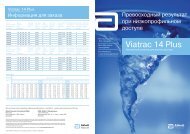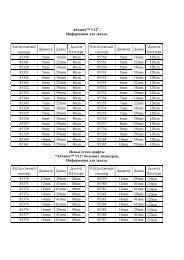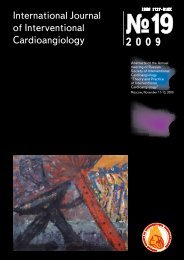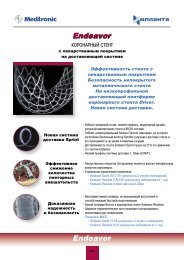Results of Coronary Stenting using the Stents with
Results of Coronary Stenting using the Stents with
Results of Coronary Stenting using the Stents with
Create successful ePaper yourself
Turn your PDF publications into a flip-book with our unique Google optimized e-Paper software.
Interventional cardiology<br />
Fig. 3. Selective coronary angiogram <strong>of</strong> <strong>the</strong> left<br />
coronary artery: <strong>the</strong> LAD cannot be visualized.<br />
The middle segment <strong>of</strong> <strong>the</strong> OMB is stenotic (>75%)<br />
nary artery was ca<strong>the</strong>terized <strong>with</strong> <strong>the</strong> guiding ca<strong>the</strong>ter<br />
Mach 3.5 SH (Boston Scientific), mechanical<br />
recanalization <strong>of</strong> <strong>the</strong> occluded LAD was performed<br />
<strong>using</strong> hydrophyle Shinobi guidewire (Cordis). The<br />
LAD was dilated <strong>using</strong> balloon ca<strong>the</strong>ter 1,5 x 20mm<br />
(Cordis), and <strong>the</strong>n stented <strong>with</strong> a DES Taxus express<br />
3,0 х 20 mm (Boston Scientific) (Fig. 4 а,b). The stent<br />
was completely deployed under 14 Atm. pressure.<br />
After that we performed direct stenting <strong>of</strong> <strong>the</strong> OMB<br />
<strong>using</strong> Promus Element stent 3,5 х 28 mm (Boston Scientific)<br />
(Fig. 5 а,b) <strong>with</strong> good angiographic results.<br />
At <strong>the</strong> second stage <strong>of</strong> <strong>the</strong> procedure endovascular<br />
ASD closure was performed. The right femoral<br />
vein was punctured under local anes<strong>the</strong>sia and a 6F<br />
introducer was inserted. The ca<strong>the</strong>terization <strong>of</strong> <strong>the</strong><br />
left upper lobe pulmonary vein was performed <strong>using</strong><br />
multipurpose 6F ca<strong>the</strong>ter. Then a 34-mm sizing balloon<br />
was advanced <strong>using</strong> Amplatzer guide 0,035<br />
x 260 cm and <strong>the</strong> defect size was determined. As<br />
<strong>the</strong> defect’s edges were dysplastic, we have chosen<br />
33 mm Figula Flex occluder. The occluder was<br />
placed under fluoroscopic guidance <strong>using</strong> generally<br />
adopted technique. At first <strong>the</strong> left occluder branch<br />
was deployed into <strong>the</strong> left atrium and <strong>the</strong> safety <strong>of</strong><br />
occluder fixation at <strong>the</strong> defect’s edges was checked<br />
<strong>with</strong> recurrent tractions <strong>of</strong> <strong>the</strong> delivery system. Only<br />
after that and after echocardiographic control <strong>of</strong> distal<br />
occluder branch position relative to <strong>the</strong> defect and<br />
<strong>the</strong> valvular apparatus <strong>of</strong> <strong>the</strong> LV, <strong>the</strong> proximal branch<br />
was deployed in <strong>the</strong> right atrium (Fig. 6).<br />
Control transthoracic EchoCG revealed adequate<br />
positioning <strong>of</strong> <strong>the</strong> occluder and complete deployment<br />
<strong>of</strong> both discs, <strong>the</strong>re was no shunt through<br />
<strong>the</strong> ASD. After <strong>the</strong> confirmation <strong>of</strong> secure occluder<br />
fixation <strong>the</strong> delivery system was removed. In our<br />
opinion, <strong>the</strong> process <strong>of</strong> this delivery system detachment<br />
— <strong>the</strong> removal <strong>of</strong> fittings’ block — is simple and<br />
more convenient in comparison <strong>with</strong> <strong>the</strong> widely used<br />
Amplatz ocluders. The hemostasis was achieved<br />
<strong>using</strong> manual compression. We did not observe any<br />
complications during and early after <strong>the</strong> procedure.<br />
Control transthoracic EchoCG carried out in 4 days<br />
after ASD closure confirmed good effect <strong>of</strong> <strong>the</strong><br />
procedure, <strong>the</strong> shunt through <strong>the</strong> defect was absent.<br />
In-hospital period was eventless and <strong>the</strong> patient<br />
was discharged at day 6 in a satisfactory condition.<br />
After <strong>the</strong> angioplasty <strong>the</strong> angina attacks stopped and<br />
did not recur <strong>the</strong>reafter. There were no changes on<br />
<strong>the</strong> ECG.<br />
At <strong>the</strong> examination performed in one month <strong>the</strong><br />
patient did not present any complaint, his condition<br />
was satisfactory. The results <strong>of</strong> performed<br />
Fig. 4. а) <strong>Stenting</strong> <strong>of</strong> <strong>the</strong> proximal segment <strong>of</strong> <strong>the</strong> LAD <strong>using</strong> Taxus express DES (3x20mm);<br />
b) Immediate result <strong>of</strong> stenting<br />
12<br />
(№ 26, 2011)
















